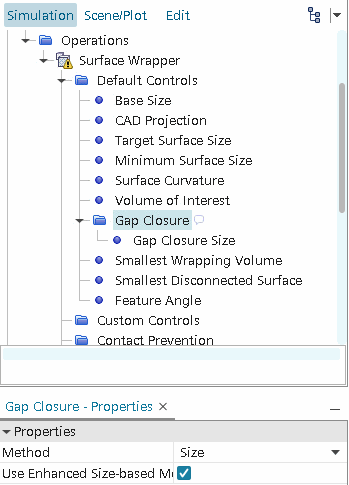Gap Closure
The surface wrapper can close holes in the input geometry which would otherwise prevent distinct separation of volumes within the mesh.
The goal of gap closure is to enhance resolution of volumes based on wall-distance. A portion of a volume must exist which is further away from the wall than the gap closure size. Then, gap closure faces are generated with the purpose of separating these volumes. The particular volume which is chosen is based on your input.

The gap closure results, for the same gap closure settings, can be different depending on the wrapper algorithm in use (default or Legacy Wrapper). You are advised to run gap closure using the default wrapper as the results can be more predictable.
Gap Closure Properties
The following options are available for Gap Closure - Properties:
| Use Enhanced Size-based Method | The
enhanced method operates on the fully refined tree after all
refinements from all size-controls have been applied to the volume.
This method also decouples contact prevention and gap closure
ensuring effective application of gap closure. By default, the
Use Enhanced Size-based Method is turned
on for new simulation files when the Gap Closure option is activated
for surface wrapper. However, if you load an old simulation file
from Simcenter STAR-CCM+ versions
prior to 2019.2, the option is turned off. Only available when you activate the Legacy Wrapper. An improved version of the Enhanced Size-based Method is already incorporated in the parallel surface wrapper algorithm. |
|
| Size | Allows you to specify gap closure Size type as an value, or Relative to base. Any holes that are smaller than the specified gap closure size are closed during surface wrapping. | |
| Seed Point | Allows you to specify
the location and the coordinate system used for the Seed
Points within your geometry. Only volumes that
contain Seed Points are closed during surface
wrapping. Generally, gaps are closed at the smallest possible
opening between the gap closure seed point and the volume of
interest. If there are multiple small openings, the wrapper does not
guarantee which one it closes. You can also use Gap Closure seed points to define target points for leak detection. For more information, see Closing Gaps and Checking for Leaks. |
|
| Both | Allows you to specify a Gap Closure Size and use gap closure Seed Points. During surface wrapping, any holes that are smaller than the Gap Closure Size are closed. Holes that are larger than the Gap Closure Size are also closed based on the gap closure Seed Points. | |